#Mobile App Prototype Development
Explore tagged Tumblr posts
Text
Mobile App Development Services | Android & iOS App Solutions – Moironix.
Get Expert Mobile App Development Services at Moironix. We Build Custom Android & IOS Apps, Hybrid Solutions, and Enterprise Mobile Applications.
At Moironix Soft Solutions, we specialize in delivering top-notch mobile application development services that empower businesses to stay ahead in today’s digital landscape. Our team of expert developers and designers is committed to creating innovative, user-friendly, and scalable mobile applications tailored to meet your unique business needs.
Mobile App Development, Custom Mobile App Development Hyderabad, Hybrid App Development Cost, React Native App Development Services, Flutter App Development for Startups, Mobile App Prototype Development
#Mobile App Development#Custom Mobile App Development Hyderabad#Hybrid App Development Cost#React Native App Development Services#Flutter App Development for Startups#Mobile App Prototype Development
0 notes
Text

#web and mobile app development services#website developers india#seo services#best web design company in india#websites#app development#web design#web development company#web developers#website design#wordpress development#web development#digital marketing#prototype
0 notes
Text
#How to convert sketches into code using Firebase#Build mobile apps from sketches Firebase#Turn wireframes into functional apps with Firebase#Firebase Studio app design to code#Firebase app development process#Firebase Studio design workflow#Firebase UI design to app conversion#best tools to convert design to code#how to use Firebase Studio for prototyping#UI to code automation Firebase#design to deployment Firebase Studio
0 notes
Text
A Complete Guide to Mobile App Prototype
Creating a successful app starts with a clear plan. A well-structured Guide to mobile app prototype helps businesses visualize design, functionality, and user flow before development. It allows companies to refine ideas, fix issues early, and ensure a smooth user experience for a high-performing final product.
0 notes
Text
Crafting Digital Experiences with Expert UI/UX Design
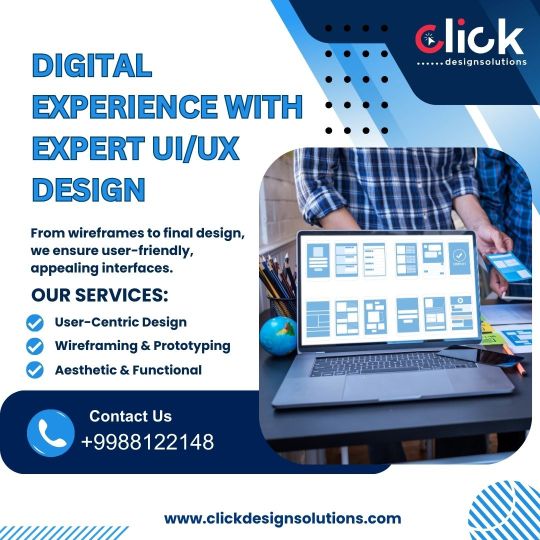
Looking to elevate your website or app? At Click Design Solutions, we bring your digital ideas to life with expert UI/UX design we offer: ✅ User-Centric Designs ✅ Prototypes that Inspire ✅ Aesthetic & Functional Interfaces
From wireframes to the final design, we create seamless, user-friendly experiences.
📞 Contact us at +9988122148 🌐 Visit: www.clickdesignsolutions.com
Follow us for design inspiration and updates! 💻✨
#User-friendly design#Website development#App design#Click Design Solutions#Innovative design#Wireframing#Prototyping#Functional design#Aesthetic website#Custom websites#User experience#Digital solutions#Mobile app design#Responsive design#Website prototypes#Seamless user interface#Interactive design#Professional design services#Website functionality#Creative web solutions#UI/UX design.
0 notes
Text
Quokka Labs offers world-class mobile app development services tailored for businesses across industries, including real estate, healthcare, and e-commerce. From mobile app testing services to cross-platform mobile app development, we deliver custom solutions with exceptional performance and scalability. As one of the top mobile app development companies, we bring your app idea to life with a focus on innovation and seamless user experience.
#Top mobile app development companies#Mobile app development for real estate#Mobile app testing services#Cross-platform mobile app development#Custom mobile app solutions#Mobile app developers#Enterprise mobile app development#App design and development#iOS and Android app development#App prototyping and testing
0 notes
Text
Prologic Technologies is one of the top companies for developing custom software and apps. For your digital projects, our committed team specializes in developing customized solutions that meet your business needs and guarantee flawless integration and unmatched functionality.
#Custom Digital Solutions for Your Business#Custom Web Development Company#Bespoke Web Application for global startups#Bespoke Mobile App Development Agency#Custom UI UX Design and prototype for mobile app
0 notes
Text
Expert Wireframing and Prototyping Services
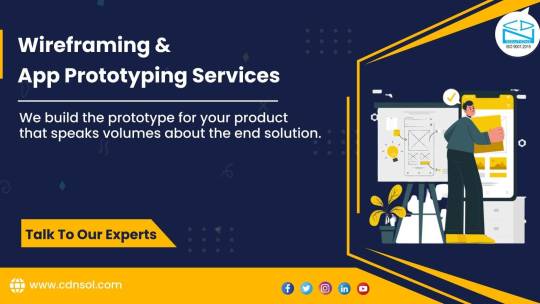
Need expert wireframing and prototyping services? Our experienced team provides app prototyping, wireframe design, and UX consultancy for mobile, web, and desktop applications. From concept to prototype, we help you visualize, test, and perfect your app’s design before full development. Whether you're looking for mobile app wireframing or complete prototyping solutions, our services ensure a seamless design process for your project. Visit now to know more: https://www.cdnsol.com/wireframing-and-app-prototyping
#wireframing and prototyping services#app prototyping services#application wireframe design services#prototyping and consultancy#experience prototype consultants#wireframe and prototype design services#app prototyping company#user experience prototyping consultancy#wireframing and prototyping development firm#wireframing and prototyping tools#mobile app prototyping services#app prototyping and wireframing services#wireframing and app prototyping#mobile app wireframing#web apps wireframing#desktop app wireframing
0 notes
Text
#No coding required#App development for non-programmers#Turn app ideas into reality#Mobile app creation#App prototyping tools#Outsourcing app development#App idea validation#Hiring app developers#Startup app solutions#App design for beginners
0 notes
Text
The Importance of User Interface (UI) and User Experience (UX) Design in App Development

Introduction
In the fast-paced world of digital solutions, the collaboration between User Interface (UI) and User Experience (UX) design is crucial for the success of mobile app development services and other digital platforms. Effective UI/UX design not only improves usability but also boosts user satisfaction, driving higher engagement and retention rates.
Why UI/UX Design Matters in App Development:
In the competitive landscape of website and mobile app development, along with cloud services, UI/UX design stands as the foundation for creating impactful digital experiences. Here’s why it’s essential:
Enhancing User Engagement and Satisfaction: UI design focuses on creating visually appealing interfaces that are easy to navigate. Meanwhile, UX design ensures seamless and enjoyable interactions within the app, leading to overall user satisfaction and loyalty.
Driving Business Success: Investing in professional UI/UX design services not only enhances app usability but also boosts conversion rates and profitability. A well-designed interface can significantly increase user adoption and brand loyalty.
Standing Out in a Crowded Market: In a saturated market of mobile app development services, distinguishing your app is critical. Exceptional UI/UX design sets your app apart by delivering a memorable user experience, which can result in positive reviews and referrals.
Conclusion
UI/UX design plays a pivotal role in app development across mobile, web, and cloud platforms. By prioritizing user-centric design principles, businesses can foster engagement, drive growth, and gain a competitive advantage in today’s digital landscape. Embracing UI/UX design ensures that digital products not only meet but exceed user expectations, paving the way for sustained success and long-term relationships.
#mobile app development services#mobile UI/UX design#mobile app prototyping#agile mobile app development#mobile app maintenance and support#mobile app marketing and strategy
1 note
·
View note
Text
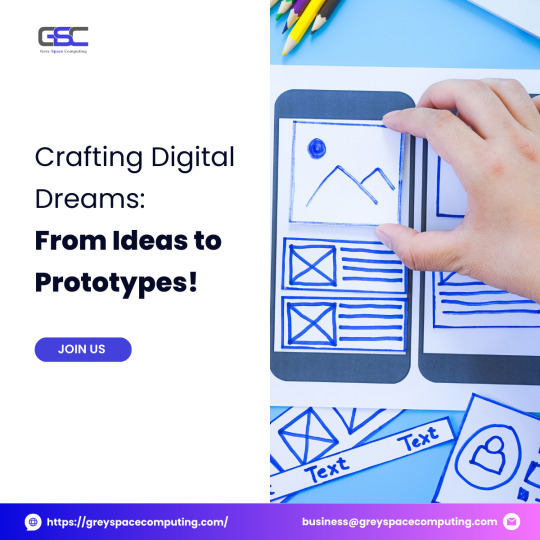
Embark on a journey of digital dreams! 🌐💡 Grey Space Computing transforms ideas into tangible prototypes, bringing your vision to life. Ready to prototype your success?
🌐 Website: https://greyspacecomputing.com/
📧 Email: [email protected]
📱 Phone: +91-98602 56990
#UIUX #Prototyping #UserExperience #wireframe #ui #ux #uxdesign #design #uidesign #userinterface #uiux #webdesign #appdesign #userexperience #interface #webdesigner #uxdesigner #dribbble #uitrends #graphicdesign #userinterfacedesign #uidesigner #website #uxinspiration #behance #dailyui #uiinspiration #uxigers #landingpage #uxui #web
#app developing company#mobile application development#mobile app company#app development#oman#dubai#qatar#web app development#ui ux development services#prototype
1 note
·
View note
Text
HS Digital Media Crafting Compelling Narratives through Ad Films
The Power of Ad Films
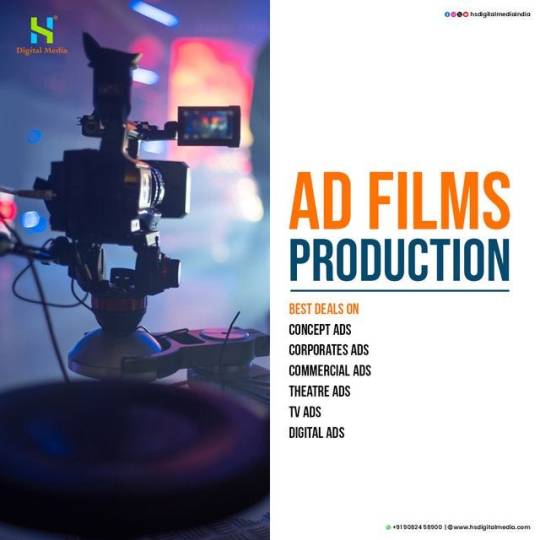
Why Choose HS Digital Media
Showcase your company’s unique selling characteristics. Highlight any awards, recognition, or successful case studies.
The Creative Process
Provide insights into how HS Digital Media approaches ad film creation. Discuss the collaboration between your team and clients. Emphasize the importance of tailoring each project to the client’s brand and goals.
Technological Edge
Detail the cutting-edge technology and equipment used by HS Digital Media. Discuss any innovative techniques or trends in the ad film industry.
The Team Behind the Magic
Introduce key members of your team and their expertise. Share any success stories or challenges overcome during previous projects.
Client Success Stories
Include testimonials from satisfied clients. Highlight specific projects and their impact on the client’s brand.
Industry Trends and Insights
Discuss current trends in ad film production. Share insights into the evolving landscape of digital media.
Challenges and Solutions
Address common challenges in ad film production. Showcase how HS Digital Media overcomes these challenges to deliver exceptional results.
Social Impact Through Ad Films
Discuss any projects that have contributed to social causes. Highlight the potential for ad films to create positive change.
The Future of Ad Films
Share your vision for the future of ad film production. Discuss emerging technologies and their potential impact on the industry.
#Mobile App Development#App Development Services#iOS App Development#Android App Development#Custom Mobile App#Mobile Application Design#Cross-Platform App Development Native App Development Mobile App Developers#Mobile App UI/UX#Mobile App Testing#Enterprise App Development#Mobile App Prototyping#App Maintenance Services#Mobile App Security#Cloud-Based App Development#Mobile App Integration#Wearable App Development#AR/VR App Development#IoT App Development#Mobile App Development Mumbai#Mumbai App Developers#iOS App Development Mumbai#Android App Development Mumbai#Mobile App Design Mumbai#Mumbai Mobile App Agency#Mumbai App Development Services#Custom App Development Mumbai#Mumbai Mobile App Solutions#Native App Development Mumbai#Cross-Platform App Mumbai#Mobile App Testing Mumbai
0 notes
Text
Testimonial
Sdreatech has completed several global websites, mobile apps, IoT applications, IoT games, and custom software projects for various corporate needs.
We also design and develop UI/UX, prototypes, UI kits, HTML, and WordPress themes.
Here are Significant statements from our clients. Click on the link👇👇
https://www.sdreatech.com/
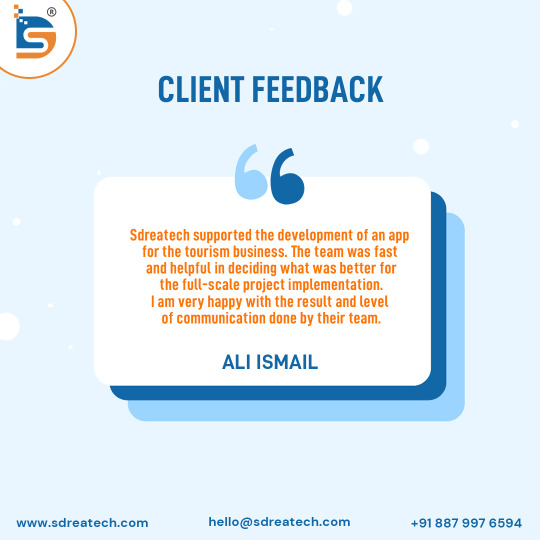
#Sdreatech has completed several global websites#mobile apps#IoT applications#IoT games#and custom software projects for various corporate needs.#We also design and develop UI/UX#prototypes#UI kits#HTML#and WordPress themes.#https://www.sdreatech.com/#testimonial#testimonialcustomer#testimonials#TestimonialTime#clientreview#feedback#clientfeedback#clienttestimonials#technology#itcompany#itcompanyindia#sdreatech
0 notes
Text
Streamline Your Website Prototyping Process With These 5 Essential Techniques
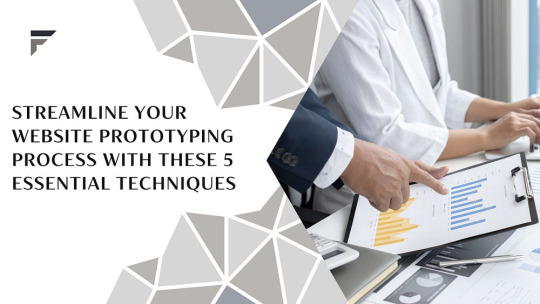
Website prototyping is a crucial step in the website design and development process. It involves creating a preliminary version of a website that can be used to test and refine the design, layout, and functionality of the website before the final version is built. The goal of website prototyping is to create a visual representation of the website that can be used to gather feedback from stakeholders, identify design issues, and improve the user experience. Website prototyping can take many forms, including sketches, wireframes, mockups, and functional prototypes. Each of these techniques allows designers and developers to explore different aspects of the website’s design and functionality, such as its layout, navigation, and interactivity.
INTRODUCTION TO WEBSITE PROTOTYPING
Prototyping is an essential part of the web design process. It helps you to test out ideas and concepts for your website before moving onto the next stage of development.
There are many different techniques that you can use when prototyping a website. The most important thing is to find a method that works best for you and your team.
In this article, we will explore some of the most popular methods for website prototyping. We will also provide tips on how to streamline your process and get the most out of your prototypes.
WHAT IS A PROTOTYPE?
A prototype is a preliminary model of something. It is often used to evaluate a concept or process before committing significant resources to further development. In other words, it allows you to test out your ideas before investing too much time or money into them.
There are many different types of prototypes, but the most common ones are paper prototypes and digital prototypes. Paper prototypes are usually created by hand, using paper and cardboard. They can be used to test out physical products, such as furniture or toys. Digital prototypes, on the other hand, are created using software such as Adobe Photoshop or Sketch. These are often used to test out websites or apps.
Creating a prototype can help you save time and money in the long run. It can also help you avoid potential problems with your product or service before they become too expensive to fix.
5 ESSENTIAL TECHNIQUES TO STREAMLINE YOUR PROTOTYPING PROCESS:
If you’re tired of your website prototyping process taking forever, it’s time to streamline it with some essential techniques. Here are a few things you can do to speed things up:
1. Use a tool like Balsamiq Mockups to quickly create wireframes. This will help you get a basic structure in place before fleshing out the details.
2. Use InVision or MarvelApp to create interactive prototypes. These tools let you add interactions and animations, so you can get a feel for how the final product will work.
3. Get feedback early and often. Don’t wait until the end of the process to get feedback from users or stakeholders. Get it throughout, so you can make changes along the way.
4. Make use of templates. There’s no need to start from scratch every time you prototype something. Find a template that’s close to what you need and adapt it as needed.
5. Automate repetitive tasks. If there are any tasks that you find yourself doing over and over again, see if there’s a way to automate them with a tool or script. This will save you time in the long run.
– CONTENT STRATEGY & PLANNING
Assuming you have your website wireframes in hand, it’s time to move on to the content strategy and planning stage. This is where you’ll start fleshing out the details of your site’s pages and posts, and deciding what content you need to create or procure.
To streamline this process, there are a few essential techniques you can use:
1. Define Your Site’s Purpose and Goals
Before you can start planning your site’s content, you need to know what its purpose is. What are you trying to achieve with your website? What goals do you want it to help you reach? Once you have a clear understanding of its purpose, you can start mapping out what content needs to be included on each page.
2. Identify Your Target Audience
Who is your target audience? Who are you creating this website for? Once you know who your audience is, you can start tailoring your content strategy to them. What kind of information do they need? What kind of tone should you use? Keep your target audience in mind as you plan and create your site’s content.
3. Create an Editorial Calendar
An editorial calendar is a great way to plan out and manage your website’s content. It helps you keep track of what content needs to be created, when it should be posted, and who is responsible for creating it. When used properly, an editorial calendar can help ensure that all content is created on time and distributed according to plan.
4. Brainstorm Content Ideas
Now that you know your audience and have an editorial calendar in place, it’s time to start brainstorming content ideas. What kind of content should you create? How can you make your content interesting and useful for your audience? Think about how each piece of content will fit into the overall structure of your site, and use that to guide your ideas.
5. Establish Quality Standards
Finally, establish some quality standards for the content you create or procure. What topics are off-limits? What style guidelines should contributors follow? Set clear expectations so everyone involved in the creation process knows what they need to do in order to produce high-quality work.
– WIREFRAMING
Wireframing is the process of creating a low-fidelity mockup of your website or application. This mockup can be in the form of a hand-drawn sketch, a digital wireframe, or even just a set of written notes.
The purpose of wireframing is to help you take a step back from the details and think about the overall structure of your site or app. What pages will it have? What will the user flow be? How will users interact with the interface?
Answering these questions early on will save you a lot of time and headache down the road. Trust us, we’ve been there!
There are many different ways to create wireframes, but we prefer using digital tools like Balsamiq or Adobe XD. These programs allow you to quickly create clickable prototypes that you can share with stakeholders for feedback.
– MOCKUPS & DESIGN ITERATION
When it comes to streamlining your website prototyping process, one of the most essential techniques you can use is mockups. Mockups are essentially low-fidelity versions of your proposed design, and they can be used to test out various layout, content, and overall aesthetics before settling on a final design.
There are a few different ways to create mockups, but one of the simplest is to use a program like Photoshop or Sketch. Once you have your basic layout down, you can start adding in placeholder content and images to get a better sense of how everything will come together.
It’s important to keep in mind that mockups are not meant to be perfect; they’re simply meant to give you an idea of what your final product might look like. As such, don’t spend too much time agonizing over small details; instead, focus on getting a general feel for the overall design.
Once you’ve created a few mockups, it’s time to start iterating on them. This means making changes and tweaks based on feedback from yourself or others. Again, don’t get too hung up on small details; rather, focus on making the overall experience better.
If you follow these steps, you’ll find that streamlining your website prototyping process is much easier than it might initially seem. With mockups and design iteration, you can quickly create a high-quality prototype that accurately reflects your vision for the final product.
– USABILITY TESTING
Usability testing is a crucial step in the web design process, yet it is often overlooked or done poorly. By taking the time to do usability testing early and often, you can save yourself a lot of time and money in the long run.
There are many different techniques that can be used for usability testing, but there are three essential techniques that every web designer should use: think-aloud protocols, cognitive walkthroughs, and eye tracking.
Think-aloud protocols involve having your users verbalize their thoughts as they use your prototype. This helps you to understand what they are thinking and why they are doing certain things.
Cognitive walkthroughs involve observing your users as they use your prototype and asking them questions about their thought process. This helps you to understand how they are trying to accomplish their task and what they expect to see.
Eye tracking involves using special software to track where your users are looking on your prototype. This can help you to identify areas that are causing confusion or that are being ignored altogether.
– RAPID PROTOTYPING TOOLS
1. Rapid Prototyping Tools
There are a number of different rapid prototyping tools available on the market today. These tools can help you quickly create prototypes for your website, without having to code or design from scratch.
Some of the most popular rapid prototyping tools include:
Invision: Invision is a popular prototyping tool that allows you to create clickable mockups and prototypes of your website or app. It’s easy to use and has a wide range of features, making it a great choice for both beginners and experienced designers alike.
Marvel: Marvel is another popular prototyping tool that’s similar to Invision in terms of functionality. It’s easy to use and also offers a wide range of features, making it a great choice for those looking to create complex prototypes.
Proto.io: Proto.io is a powerful prototyping tool that offers a wide range of features and capabilities. It’s suitable for more experienced designers who are looking for a tool that can help them create complex prototypes quickly and easily.
CONCLUSION
Prototyping is a vital part of the website design process and it can be made easier when you use specific techniques. By following our five essential tips, you can streamline your prototyping process and create web designs that are both creative and functional. With these tools at your disposal, you’ll have an easier time turning your ideas into reality!
#Streamline Your Website Prototyping Process With These 5 Essential Techniques#Social Media Marketing & Management Services#Mobile App Development services#Multimedia / Flash Animation Services#Reliable seo consultant
1 note
·
View note
Text
A-Café (Update #25) - Community Discussion
Good morning everyone! I know it's been a while since I've posted, but I'm finally back with another community update. In the first part, I'll be giving a brief overview of where we're at in terms of project progress. Then, in the second half, we'll discuss a new development in app accessibility.
Without further ado, let's begin!
1) Where are we at in the project currently?
A similar question was asked in the A-Café discord recently, so I figured I'd include my response here as well:
Right now we’re reworking the design of A-Café, both visually and architecturally. The initial planning and design phase of the project wasn’t done very thoroughly due to my inexperience, so now that I’m jumping back into things I want to ensure we have a solid prototype for usability testing. For us that means we’ve recently done/are doing a few things:
analyzing results from the old 2022 user survey (done)
discussing new ideas for features A-Café users might want, based on the 2022 user survey
reevaluating old ideas from the previous app design
making a new mock-up for usability testing
Once the mock-up is finished, I plan on doing internal testing first before asking for volunteer testers publicly (the process for which will be detailed in an upcoming community update).
2) Will A-Café be available for iOS and Android devices?
Yes! In fact, the first downloadable version of A-Café may no longer be so device-specific.
What do I mean by that? Well, in the beginning, the plan for A-Café was to make two different versions of the same app (iOS and Android). I initially chose to do this because device-specific apps are made with that device's unique hardware/software in mind--thus, they have the potential to provide a fully optimized user experience.
However, I've since realized that focusing on device-specific development too soon may not be the right choice for our project.
Yes, top-notch app performance would be a big bonus. But by purely focusing on iOS and Android devices for the initial launch, we'd be limiting our audience testing to specific mobile-users only. Laptop and desktop users for example, would have to wait until a different version of the app was released (which is not ideal in terms of accessibility).
Therefore, I've recently decided to explore Progressive Web App development instead.
[What is a Progressive Web App?]
A Progressive Web App (or PWA) is "a type of web app that can operate both as a web page and mobile app on any device" (alokai.com)
Much like a regular mobile app, a PWA can be found through the internet and added to your phone's home screen as a clickable icon. They can also have the ability to work offline and use device-specific features such as push-notifications.
Additionally, due to being web-based applications, PWAs can be accessed by nearly any device with a web browser. That means regardless of whether you have an iOS or Android device, you'd be able to access the same app from the same codebase.
In the end, a PWA version of A-Café should look and act similarly to an iOS/Android app, while also being accessible to various devices. And, due to having only one codebase, development of PWAs tends to be faster and be more cost-effective than making different versions of the same app.
To be clear, I haven't abandoned the idea of device-specific development entirely. We could launch iOS/Android versions of A-Café in the future if demand or revenue end up being high enough. But as of right now, I don't believe doing so is wise.
[What Does this Mean for me as a User?]
In terms of app installation and user experience, not much should hopefully change. I'd like to have A-Café available on both the Apple App Store and Google Play Store.
There will also be the option of searching for A-Café via your device's web browser, and then installing it on your home screen (iOS devices can only do so using Safari). We will likely rely on this method until we can comfortably ensure user access to A-Café on the Apple App Store and Google Play Store.
-------------
And that's it for now! Thank you for reading this latest community update. For more insight into the development process, consider joining the A-Café discord. If you have any questions or concerns regarding this post, we would love to hear your input in the comments below. See you later!
26 notes
·
View notes
Text
Not sure where to ask this, so im posting here as well as some forums BUT:
Basically I really love using Figma for making interactive menus. I have used Figma for mocking up websites and mobile apps before at my job, and in my odd time I’ve taken to using figma to prototype and make sketches of things like UI and flowcharts for the game my friends and I are developing. And even more recently I prototyped a fully custom, nice-looking, interactive character sheet for my character in the current campaign im playing.
Now, It’s got me thinking: I would really, really love to build custom character sheets for people as a side job as its something i genuinely enjoy doing. But the problem is, figma will not exist forever and I have foreseen that it might be a pain to build someone a prototype and I am the sole person to make updates whenever their character levels, they get new gear etc and I don’t really like the idea of forcing people to make an account for a tool they wont want to learn or use outside of the prototype i send them. Additionally, Figma prototype is ultimately not ideal for more distinguished and specific character sheets as I’d like for it to be.
For example, I would love to make buttons that a user can tap to mark how many death saves they have succeeded or failed, I want the user to be able to mark for inspiration and conditions, etc. I know I could possibly feasibly make it work all inside one scrollable frame, but the way I prefer to set up the character sheets requires navigating to different frames with buttons.
What other good alternatives are there? I like to make these character sheets for mobile use (phones and tablets) so should I jump to app development? I don’t mind learning new or more complicated softwares, just as long as the software is free, there’s a free trial long enough for me to learn the gist of the software, a single larger purchase for a license for a good amount of features, or the cost for subscription is low. Is Godot a good software to use for this? My team is learning godot anyway for our game as we were discouraged from Unreal Engine.
#data diary#figma#dnd#character sheets#i dont really know what else to tag with this lol#tech help#software development#godot#mobile apps#app development
20 notes
·
View notes